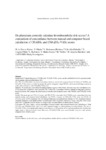Do physicians correctly calculate thromboembolic risk scores?: a comparison of concordance between manual and computer‐based calculation of CHADS2 and CHA2DS2‐VASc scores

Ver/
Use este enlace para citar
http://hdl.handle.net/2183/21961Coleccións
Metadatos
Mostrar o rexistro completo do ítemTítulo
Do physicians correctly calculate thromboembolic risk scores?: a comparison of concordance between manual and computer‐based calculation of CHADS2 and CHA2DS2‐VASc scoresAutor(es)
Data
2016-03-01Cita bibliográfica
Esteve-Pastor MA, Marín F, Bertomeu-Martínez V, et al. Do physicians correctly calculate thromboembolic risk scores?: a comparison of concordance between manual and computer‐based calculation of CHADS2 and CHA2DS2‐VASc scores. Intern Med J. 2016; 46(5): 583-589
Resumo
[Abstract] BACKGROUND: Clinical risk scores, CHADS2 and CHA2 DS2 -VASc scores, are the established tools for assessing stroke risk in patients with atrial fibrillation (AF).
AIM: The aim of this study is to assess concordance between manual and computer-based calculation of CHADS2 and CHA2 DS2 -VASc scores, as well as to analyse the patient categories using CHADS2 and the potential improvement on stroke risk stratification with CHA2 DS2 -VASc score.
METHODS: We linked data from Atrial Fibrillation Spanish registry FANTASIIA. Between June 2013 and March 2014, 1318 consecutive outpatients were recruited. We explore the concordance between manual scoring and computer-based calculation. We compare the distribution of embolic risk of patients using both CHADS2 and CHA2 DS2 -VASc scores
RESULTS: The mean age was 73.8 ± 9.4 years, and 758 (57.5%) were male. For CHADS2 score, concordance between manual scoring and computer-based calculation was 92.5%, whereas for CHA2 DS2 -VASc score was 96.4%. In CHADS2 score, 6.37% of patients with AF changed indication on antithrombotic therapy (3.49% of patients with no treatment changed to need antithrombotic treatment and 2.88% of patients otherwise). Using CHA2 DS2 -VASc score, only 0.45% of patients with AF needed to change in the recommendation of antithrombotic therapy.
CONCLUSION: We have found a strong concordance between manual and computer-based score calculation of both CHADS2 and CHA2 DS2 -VASc risk scores with minimal changes in anticoagulation recommendations. The use of CHA2 DS2 -VASc score significantly improves classification of AF patients at low and intermediate risk of stroke into higher grade of thromboembolic score. Moreover, CHA2 DS2 -VASc score could identify 'truly low risk' patients compared with CHADS2 score.
Palabras chave
Atrial fibrillation
Stroke risk score
Oral anticoagulation
Antithrombotic treatment
CHA2-DS2-VASc score
Stroke risk score
Oral anticoagulation
Antithrombotic treatment
CHA2-DS2-VASc score
Versión do editor
Dereitos
This is the peer reviewed version of the article which has been published in final form at Wiley Online Library. This article may be used for non-commercial purposes in accordance with Wiley Terms and Condiitons for self-archiving.
ISSN
1444-0903





